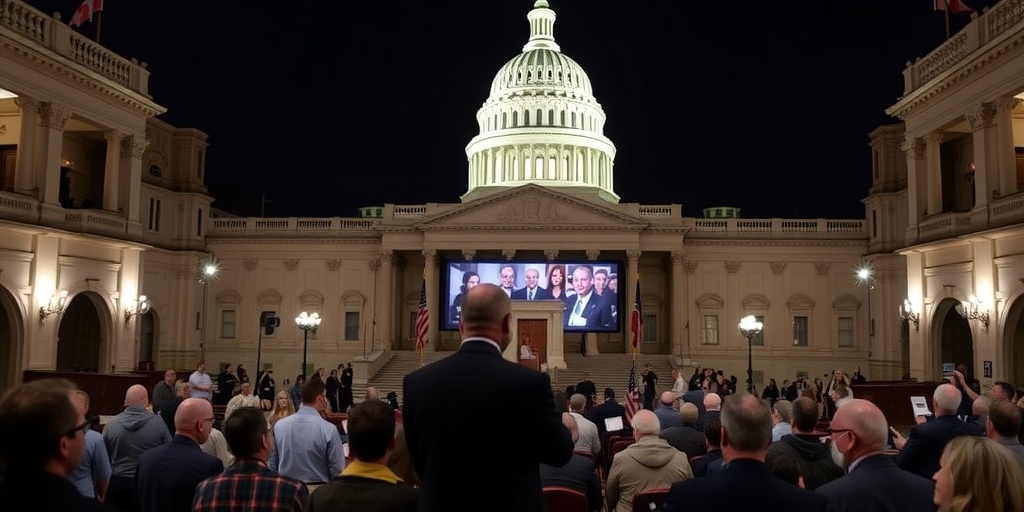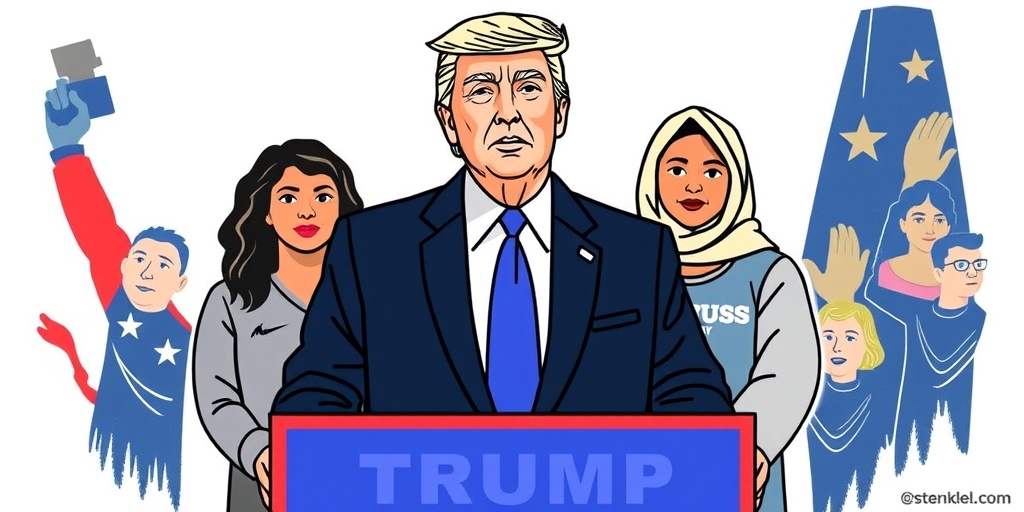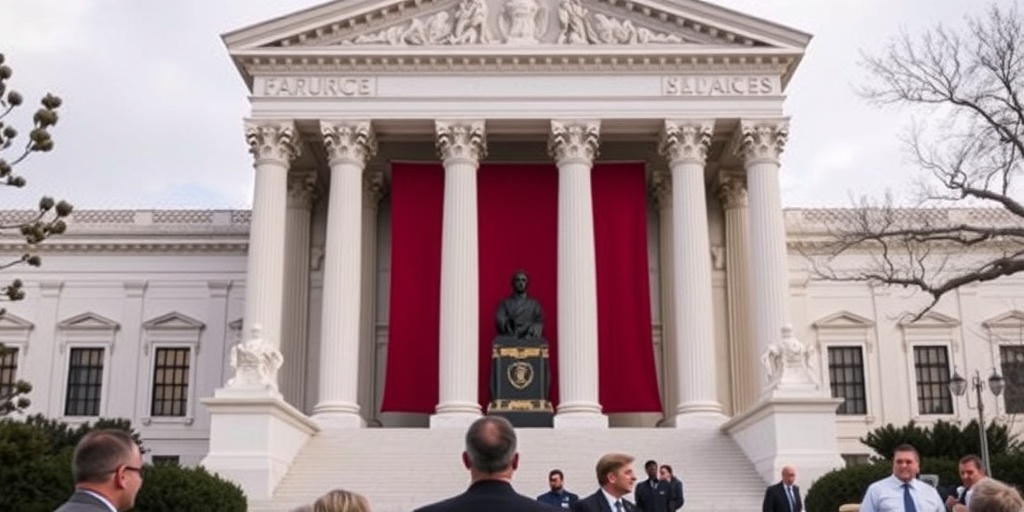Now Reading: Senate Holds All-Night Vote-a-Thon Amid GOP Budget Push
-
01
Senate Holds All-Night Vote-a-Thon Amid GOP Budget Push
Senate Holds All-Night Vote-a-Thon Amid GOP Budget Push

Senate Faces Showdown Over Budget Blueprint Amidst Political Tensions
On Friday, the Senate barreled toward a critical political confrontation concerning President Trump’s domestic initiatives. Democrats are gearing up for a series of votes during an overnight session to contest Republicans’ efforts to advance what has been described as a “one big beautiful bill” involving comprehensive spending and tax cuts. This moment comes at a time of heightened partisanship, as both parties grapple with differing visions for the future of the nation’s fiscal policy.
In order for the Republican Party to proceed with its ambitious budget blueprint, they must first unlock a legislative mechanism known as reconciliation. This process enables lawmakers to fast-track budget legislation through Congress, effectively shielding it from potential filibuster attempts. However, disagreements among Republicans in both the House and Senate over the content of this budget have left them at a standstill for weeks. To move forward, they have finally reached a fragile and intricate compromise.
Senate Majority Leader John Thune of South Dakota emphasized the significance of the budget resolution in a recent statement. “This resolution is the first step toward a final bill to make permanent the tax relief we implemented in 2017 and deliver a transformational investment in our border, national, and energy security,” he remarked, highlighting the administration’s priorities for the upcoming fiscal agenda.
A defining feature of the Senate’s procedure is the opportunity for members to propose a multitude of amendments to budget measures, known as a “vote-a-rama.” This process typically results in an intense series of rapid-fire votes that can extend well into the night. Although the amendments put forth are unlikely to become law, they serve a strategic purpose: allowing the minority party to compel the majority to take politically sensitive positions that may later be leveraged in campaign advertisements.
Democrats are planning to utilize this opportunity to challenge Republicans on key issues, including President Trump’s escalating trade war, cuts to Medicaid, and the recent implementation of cost-saving measures through initiatives like Elon Musk’s Department of Government Efficiency. “All day long, Democrats are going to come to the floor to expose the sheer destruction of the Republican agenda,” asserted Senate Minority Leader Chuck Schumer of New York at a Capitol news conference on Friday.
At the center of this legislative clash is the budget resolution itself, which raises important questions left unanswered by its authors. House Republicans, earlier in the year, passed legislation intended to pave the way for a significant budgetary bill featuring $4.5 trillion in tax cuts and a proposed $2 trillion reduction in federal spending over the next decade. Conversely, the Senate version of the budget took an alternate route, choosing to eschew specific commitments regarding taxes and spending cuts while advocating for a $150 billion increase in military spending and an additional $175 billion for border security over the same period.
Instead of reconciling these divergent priorities directly now, Senate Republicans seem to have opted to defer decisions on substantial issues, such as the extent of spending cuts required to balance the tax reductions. This approach raises concerns about the long-term implications of their strategy. On paper, the newly proposed Senate budget outline permits $1.5 trillion in tax cuts, which may appear modest; however, it masks an additional $3.8 trillion allocated for the extension of the 2017 tax cuts. Republicans argue that this extension should not count as a cost on the federal balance sheet, complicating fiscal assessments.
With the 2017 tax cuts set to expire at the end of the year, their extension is critical, though Republicans believe they can navigate around established budget rules and label this move as cost-free. In reality, the total tax cut envisioned in the Senate’s budget outline reaches approximately $5.3 trillion over a decade, with $1.5 trillion earmarked for new tax initiatives, including a proposal from Trump to exempt tips from taxation. This figure significantly surpasses the $4.5 trillion allocated by House Republicans.
Significant disparities remain between the budget plans proposed by the House and Senate. The Senate’s additional spending on defense and immigration, alongside minimal cuts, could lead to an increase in the debt by roughly $5.7 trillion over the next decade. They have proposed a $5 trillion increase in the debt ceiling, compared to the House plan’s $4 trillion increment. Meanwhile, House Republicans are aiming for substantial spending cuts to keep their overall package’s cost at $2.8 trillion.
Some Republicans in the House express concerns about supporting a Senate resolution that fails to promote greater fiscal prudence. “Let’s be truthful about this; let’s worry about our debt,” stated Representative Greg Murphy, a Republican from North Carolina. “If we’re not going to worry about our debt, I don’t know how that works.” As the Senate prepares for this pivotal showdown, the outcome will undeniably have significant ramifications for the nation’s financial future and political landscape.
As the debate unfolds, it will be crucial to monitor how these planned votes and amendments shape the views and discussions leading into the crucial stages of budget negotiations. The dynamics at play highlight not only the contentious nature of contemporary governance but also the broader implications of the fiscal strategies that will determine the country’s economic direction in the coming years.
Stay Informed With the Latest & Most Important News
Previous Post
Next Post
-
 01New technology breakthrough has everyone talking right now
01New technology breakthrough has everyone talking right now -
 02Unbelievable life hack everyone needs to try today
02Unbelievable life hack everyone needs to try today -
 03Fascinating discovery found buried deep beneath the ocean
03Fascinating discovery found buried deep beneath the ocean -
 04Man invents genius device that solves everyday problems
04Man invents genius device that solves everyday problems -
 05Shocking discovery that changes what we know forever
05Shocking discovery that changes what we know forever -
 06Internet goes wild over celebrity’s unexpected fashion choice
06Internet goes wild over celebrity’s unexpected fashion choice -
 07Rare animal sighting stuns scientists and wildlife lovers
07Rare animal sighting stuns scientists and wildlife lovers





















